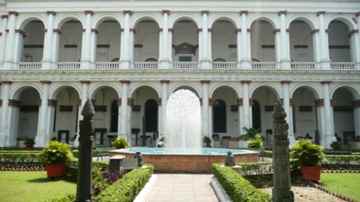The 175-year-old Indian Museum is finally headed for some massive makeover. Authorities' failure to arrive at a concrete restoration plan coupled with indiscriminate repair work, carried out over the years without paying attention to its heritage status, have already taken a toll on the building, a major landmark on Chowringhee Road.
 Two years ago, the authorities had announced with much fanfare that the entire structure would be restored. However, the plan was shelved as that would have not only led to a closure of the museum for at least two years but also the problem of storing the priceless artefacts during that period.
Two years ago, the authorities had announced with much fanfare that the entire structure would be restored. However, the plan was shelved as that would have not only led to a closure of the museum for at least two years but also the problem of storing the priceless artefacts during that period.
In the last two years, the condition of the building has deteriorated. Chunks have fallen off the ground-floor ceiling at least five times, forcing museum authorities to carry out part-wise restoration of the building. Central Public Works Department under the guidance of the Archaeological Survey of India has begun work on at least five deep fissures on the ceiling. But this will reportedly not resolve the issue at hand.
About two decades ago, the original sandstone floor of the building had been replaced and that started the problem. Mosaic floor tiles were introduced in the name of modernization. Similarly, cracks and peels on the walls were repaired with modern building material like concrete and painted off. "Sandstone used to bring up moisture from the floor and release it on the surface from where it evaporated. Similarly, lime and mortar, the original building material for the walls, also helped to bring up moisture from inside and release it into the air. But mosaic tiles on the floor and the concrete walls trap moisture inside, weakening the structure. Through capillary movement, the moisture has now moved up to the ceiling," explained an official.
Restoration of the walls has started and many areas of the museum have been cordoned off. "We have to expose the walls till we reach the bricks, cure the dampness and bring back the lime walls that were original to the building," said a senior official. "It's a matter of curing 37-ft-high walls that are 40-ft thick," he added.
Several galleries have been shut because of the damage the building has suffered already. The premium Harappan Gallery, for example, has remained closed for the past 10 years. It has collections like the Dancing Girl of the Indus Valley Civilisation and the Pashupati Seal. Viewers from all over the world and children especially come to the museum to see this gallery, but have to return disappointed. "We have plans for this gallery. We will open it soon," was all that director KK Basa said. Among the other wings that lie closed are the decorative art gallery, minor art gallery and musical gallery.
Basa, who is also on his way out, revealed a series of plans shifting of the library and creating a new coins gallery among others.
But what about the fact that some of the invaluable possessions are also in immediate need of restoration? At the paintings gallery, colour is peeling off from a large number of Mughal and European art works of the 18th and 19th centuries. Some years ago, airtight glass showcases were built around the most valuable paintings on display, but experts said that a lack of air circulation around the canvases actually caused the damage.
Source: The Times of India [December 16, 2010]